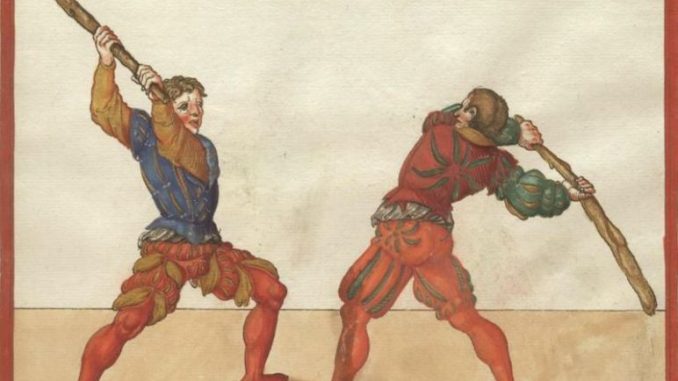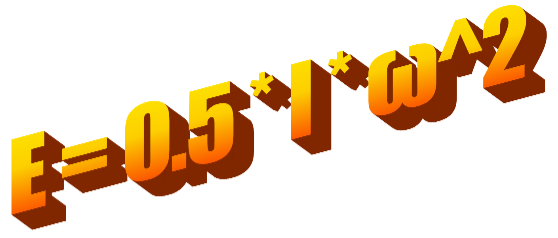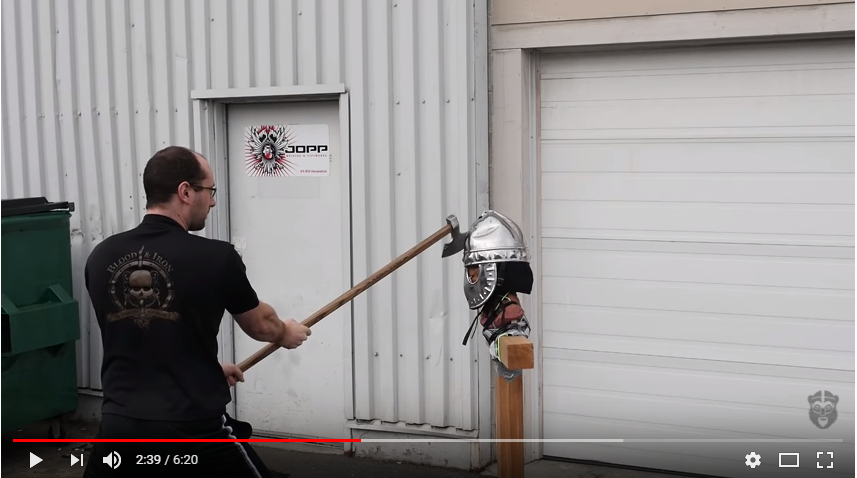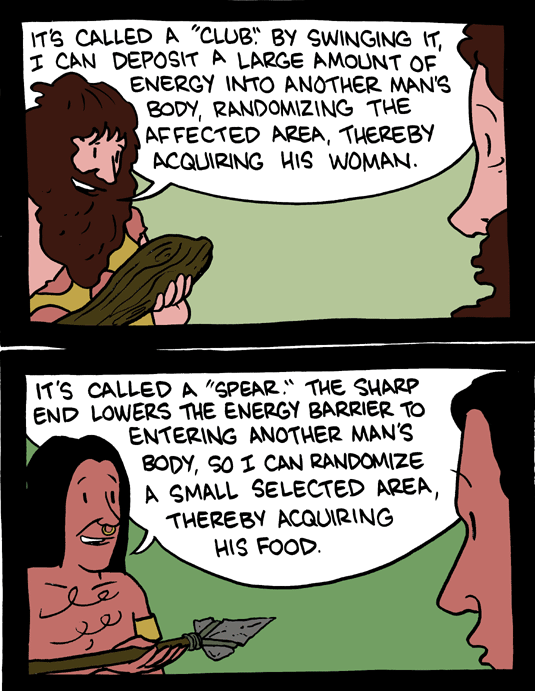
Unfortunately, ‘Hard’ in our everyday context is a little ambiguous from a physics point of view. “That person hits too hard*! You don’t have to hit hard to cut with a sword!” These comments are actually somewhat devoid of substance. Let’s get a little more educated as to what a ‘hard’ strike entails**.
*If you are hitting at a level that compromises safety or the comfort level of your partners, it is objectively too hard.
** This is about actual strikes, ones that impact a target. Slowing down your strike so that you don’t hit you training partners when you aren’t wearing gear is a different topic for another day.
Speed
First card to put down on the table is the relation speed has to everything. You may have tried very hard to forget the following formula from grade school physics:
![]()
And its friend you (probably) didn’t see in high school, the formula for the kinetic energy of a rotating object:

What does it mean?
- Double the mass of an object in motion and you double its kinetic energy.
- Double the speed of an object in motion and you quadruple its kinetic energy.
This basically means that, everything else being equal, fighters who are more skilled (and hence faster) are going to be hitting ‘harder’ when they apply the same level of control.
Will a more skilled fighter have a higher level of control? One would certainly hope so. But the fact of the matter is that they will have to be pulling more out of their punches than a fighter who just plain old moves their sword slower.
It also means that if you have two fighters who are faster, and are trying fight at a high level against each other, the blows are going to be coming in ‘harder’ than slower individuals fighting at the same intensity.
Peak Force vs Momentum
I’ll forgo an in-depth discussion of force/energy/momentum for another day, and get to the concepts you can understand more intuitively:
A while ago, I had an opportunity to appear on Skallagrim’s YouTube channel to help test some swords against helmets he’d been accumulating. One of the interesting takeaways was when I tried to strike – first with proper striking mechanics, and then again doing the hugest overswing I could manage.
Any prediction as to which did more damage? You can check the video below, or just take my word for it. https://youtu.be/hyVnPGCdnok?t=2m37s (This is not a test for historical accuracy, just destroying helmets on YouTube for fun.)

You probably guessed that it wasn’t the simple answer, or else I never would have brought it up. They both did the same damage to the helmet! How is this possible?
In both cases, the tip of the axe was moving at approximately the same speed. From our formula above, we know that they would therefore have about the same energy. This energy is what is capable of denting the steel helmet, and also what would cut through the clothing of whoever is on the end of your sword strike.
So what did putting in the huge overswing do for me? The sword stand sure noticed! The difference in the amount I knocked the stand over was significant. Though it only brought as much of the same damaging speed/energy to the strike, there was a lot of momentum behind it. This is something else that can be factored in to hitting hard: if you are throwing a lot of extra body weight into the cut to wallop your training partners, it isn’t making you a better martial artist.
Body Structure
An important concept we should understand when talking about strikes with a lot of weight behind them is the body structure.
If you watched the video above, you may have noticed how much I tensed my forearms right before impact. This is because I ideally would like for my whole body to act as a rigid structure. There are two ways that I accomplish such a thing:
- Put all my joints in good position to transfer force through my body on impact.
- Tense my muscles at the point of impact so that my structure doesn’t collapse.
Both of these are very important to train for martial artists. One needs to have the ability to go beyond touch and into the realm of causing serious injury.
Being aware of how body structure works is also key to another very important activity; not causing serious injury to the people we practice and compete with! For instance, by relaxing the muscles right before the moment of impact, you can severely reduce how ‘hard’ a strike hits your sparring partner.
This doesn’t eliminate the impact. The sword will still be moving very quickly, as we learned in the section on speed and energy. But we can take a lot out of it while still practicing making contact with realistic cutting mechanics. Incidentally, this is why hand-parries can be so dangerous – the attacker is expecting to relax right before the strike hits the body, and instead encounters a hand while they are still locked into a strong cutting position.
The other ‘strategy’ is just to have weak striking mechanics to begin with. Oftentimes, as practitioners take up activities like test cutting, their partners will start telling them they are hitting so much harder. But they weren’t trying to do so at all! This is because their bodies are now in a much better alignment when they land their strike, and swinging equally ‘hard’ leads to a much harder blow. While a great thing from a martial arts point of view, it also necessitates another learning journey into the idea of relaxing before impact. 😉
Blunt vs Sharp
The last piece I’m going to add is the difference between sharp and blunt impacts. Swords are designed to cut things[citation needed]. Even though we are fighting with blunt swords, naturally we are looking to use them in a way that trains us for using sharp swords.
This is important because blunt and sharp weapons injure in different ways. The sharp impact seeks to separate the bonds of your feeble flesh, making one thing into two things. The best way to do this is to deliver as little energy as possible into the target, and keep as much as possible invested in the sword’s speed. In practice, this means the sword slows down as little as possible as it cuts through.
A blunt impact, on the other hand, does not cut through the target. The job is to transfer as much energy into the target as possible, disrupting the internal structure.

I would be lying if I said that adding more momentum didn’t help with sharp damage at all. If you throw more weight into a cut, you will probably be able to cut deeper than you would have without doing so, but improving things like blade rotation, body structure, and edge alignment will help so much more.
Throwing a lot of weight into your cut does wonders for the blunt damage, however. This is especially bad in sparring, as we are using blunt swords. Striking in a way that makes sparring more dangerous, but doesn’t help cutting with an actual sword? Not a real winner in my book.
Putting together the pieces
When people say that a sword doesn’t have to hit hard to do damage, they mean one of two things:
- A sword does its work by achieving a high tip speed, and adding a lot of extra body weight behind the blow doesn’t add much.
- They feel people shouldn’t do martial arts with high intensity and misquote the people from #1 above to justify it.
When you are swinging a sword to cut a target it doesn’t mean that the sword is coming in ‘light’. The speed and structure of your strike will have significant injury potential.
What we should be seeking to do is:
- Eliminate is the excessive weight that is added to strikes for no good reason. This wouldn’t make a sword cut particularly better, tends to throw us off balance, and increases injury potential to ourselves and others.
- Learn to relax before impact, creating a looser connection between your body and the sword.
But you didn’t give a concise definition of what ‘hard’ means.
Nope, I did not! It’s a rather complex topic, given things like force, energy, momentum, impact time, and failure conditions. I’ll be picking away at these in the future.
This article has been somewhat less concise and to the point than I normally like. So it’s time to summarize. Do the things with smiley faces next to them, and try to reduce the things with frowny faces next to them.
![]() The faster a sword moves, the ‘harder’ it will hit. All other things being equal, fighters who can move the sword faster will naturally hit harder than a fighter who can not.
The faster a sword moves, the ‘harder’ it will hit. All other things being equal, fighters who can move the sword faster will naturally hit harder than a fighter who can not.
![]() Better body structure makes the sword hit ‘harder’, even if the person throwing it didn’t make any extra effort.
Better body structure makes the sword hit ‘harder’, even if the person throwing it didn’t make any extra effort.
![]() Throwing more body weight into the strike makes it hit ‘harder’, but doesn’t actually increase the cutting potential very much.
Throwing more body weight into the strike makes it hit ‘harder’, but doesn’t actually increase the cutting potential very much.
![]() Striking with bad cutting mechanics makes the strike hit ‘lighter’, but is very counterproductive for training.
Striking with bad cutting mechanics makes the strike hit ‘lighter’, but is very counterproductive for training.
![]() Relaxing right before impact makes the strike ‘lighter’, allowing you to move at a higher speed and with good mechanics with less risk of injury.
Relaxing right before impact makes the strike ‘lighter’, allowing you to move at a higher speed and with good mechanics with less risk of injury.
![]() Wearing the appropriate level of gear for the intensity level you are practicing at makes you much less broken!
Wearing the appropriate level of gear for the intensity level you are practicing at makes you much less broken!

